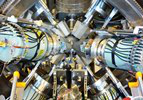Speaker
Dr
Leopold Simons
(Paul Scherrer Institute)
Description
Muonic atoms had been considered around 1974 as candidates for experiments to study neutral weak currents. Two main directions had been followed: M1(E1) mixing in s-p states and E2(E1) mixing in p-d states. After an introduction into the subject which outlines the special role of muonic atoms, the implications of the two approaches are discussed. In the M1(E1) mixing the influence of the electronic shell reduces the feasibility dramatically and was subject of intensive theoretical work which will be described in some detail.
On the side of the experiment it could be shown at PSI that a high degree of ionization could be reached for low Z muonic atoms. The two-photon transition 2s-1s could be observed for the most interesting case of muonic boron but no M1 transition has been measured so far.
In case of the E2(E1) mixing the 3d-1s transition had been observed in earlier experiments at CERN/SC for high Z muonic atoms. In a collaboration of Mainz/PSI muonic thulium could be worked out as most promising case combining some attractive features. An experiment to check the assumptions about the parameters of the mixing states has still to be performed.
For both cases the order of magnitude for parity violating effects is given
Author
Dr
Leopold Simons
(Paul Scherrer Institute)

